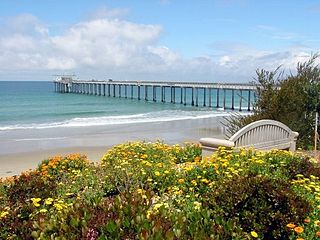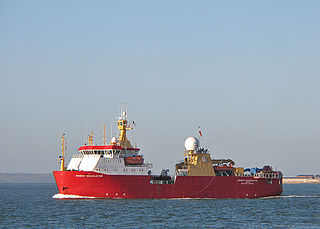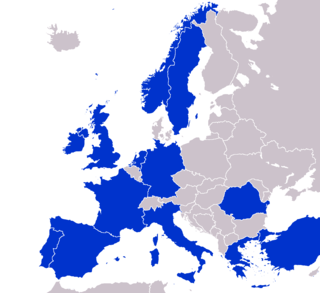Related Research Articles

Trieste is a city and seaport in northeastern Italy. It is the capital and largest city of the autonomous region of Friuli-Venezia Giulia, as well as of the regional decentralization entity of Trieste.

Scripps Institution of Oceanography (SIO) is the center for oceanography and Earth science at the University of California, San Diego. Its main campus is located in La Jolla, with additional facilities in Point Loma.
The University of Trieste is a public research university in Trieste in the Friuli-Venezia Giulia region in northeast Italy. The university consists of 10 departments, has a wide and almost complete range of university courses and has about 15,000 students and 1,000 professors. It was founded in 1924.

A research vessel is a ship or boat designed, modified, or equipped to carry out research at sea. Research vessels carry out a number of roles. Some of these roles can be combined into a single vessel but others require a dedicated vessel. Due to the demanding nature of the work, research vessels may be constructed around an icebreaker hull, allowing them to operate in polar waters.

Laura Maria Caterina Bassi Veratti was an Italian physicist and academic. Recognized and depicted as "Minerva", she was the first woman to have a doctorate in science, and the second woman in the world to earn the Doctor of Philosophy degree. Working at the University of Bologna, she was the first salaried female teacher in a university. At one time the highest paid employee of the university, by the end of her life Bassi held two other professorships. She was also the first female member of any scientific establishment, when she was elected to the Academy of Sciences of the Institute of Bologna in 1732 at 21.
The King Sejong Station (Korean: 세종과학기지) is a research station for the Korea Antarctic Research Program that is named after King Sejong the Great of Joseon (1397–1450).

Laura Bassi is an icebreaking research vessel operated by the Italian National Institute for Oceanography and Applied Geophysics,. In February 2023, she set a record by sailing further south than any ship before, achieving 78°44•280´S in the Bay of Whales, which was made possible by an unusual lack of ice. Between 1999 and 2019, she was the British Antarctic Survey (BAS) logistics ship, primarily used for the resupply of scientific stations in the Antarctic.

Yevgeny Konstantinovich Fyodorov was a Soviet geophysicist, statesman, public figure, academician (1960), and Hero of the Soviet Union (1938).

Geophysical Journal International (GJI) is a monthly peer-reviewed scientific journal in the field of geophysics. It is published by Oxford University Press on behalf of two learned societies: the Royal Astronomical Society (RAS) and the Deutsche Geophysikalische Gesellschaft, who select and peer-review the contents.
The National Institute of Geophysics and Volcanology is a research institute for geophysics and volcanology in Italy.

The BioGeM Institute is a nonprofit consortium formed by the National Research Council (CNR), the University of Naples "Federico II", the LUMSA of Rome, the Trieste AREA Science Park, the University of Udine, the Stazione Zoologica Anton Dohrn of Naples, the University of Sannio in Benevento, the University of Foggia, the University of Milan Bicocca, the Second University and the Suor Orsola Benincasa University of Naples, the Chamber of Commerce of Avellino and the local mountain community of Ufita Valley.

European Multidisciplinary Seafloor and water-column Observatory (EMSO) is a large-scale European distributed Research Infrastructure for ocean observation, enabling real-time interactive long term monitoring of ocean processes. EMSO allows study of the interaction between the geosphere, the biosphere, the hydrosphere, and the lithosphere; including natural hazards, climate change, and marine ecosystems. EMSO nodes have been deployed at key sites in European seas, starting from the Arctic, through the Atlantic and Mediterranean, to the Black Sea.
A European Research Infrastructure Consortium (ERIC) is a full juridical person and a corporation under European Union law. With a membership of at least one European Union member state and two EU member or associated states, it has legal personality and full legal capacity recognized in all Member States. Currently there are 25 ERICs established.
The International Science Council (ISC) is an international non-governmental organization that unites scientific bodies at various levels across the social and natural sciences. The ISC was formed with its inaugural general assembly on 4 July 2018 by the merger of the former International Council for Science (ICSU) and the International Social Science Council (ISSC), making it one of the largest organisations of this type.

Giuseppina Aliverti was an Italian geophysicist specializing in several fields of terrestrial physics. She is remembered for developing the Aliverti-Lovera method of measuring the radioactivity of water.

Silvia Peppoloni is an Italian geologist, researcher in the field of natural hazards and risks, science writer, and international scholar in geoethics.
Paola Malanotte Rizzoli is an Italian physical oceanographer known for her research on ocean circulation and sea level rise, especially with respect to flooding conditions in Venice.

I.CO.P. S.p.A. Società Benefit is an Italian construction company founded in 1920.
Pure and Applied Geophysics is a monthly peer-reviewed scientific journal that covers research in the field of geophysics. It is published by Birkhäuser and the editors-in-chief are Carla F. Braitenberg, Alexander B. Rabinovich, and Renata Dmowska. The journal was established in 1939 as Geofisica Pura e Applicata before obtaining its current title in 1964.
References
- ↑ "List of the Italian Research bodies supervised by the Italian Ministry of University and Research" . Retrieved 2022-10-07.
- ↑ A. Böhm, Conrad (1998). 250 anni di astronomia a Trieste [250 years of astronomy in Trieste] (in Italian). Trieste: MGSpress. ISBN 88-86424-51-5.
- ↑ Provvedimenti per l'Osservatorio geofisico sperimentale di Trieste (73) (in Italian). February 11, 1958. Retrieved 2022-10-07.
- ↑ "Istituzione dell'Istituto nazionale di geofisica e vulcanologia, nonché disposizioni concernenti gli enti di ricerca vigilati dal Ministero dell'università e della ricerca scientifica e tecnologica, a norma dell'articolo 11 della legge 15 marzo 1997, n. 59. - Art. 7 "Norme sull'Osservatorio geofisico sperimentale e sull'Istituto di ottica ((Legislative decree) 381) (in Italian). September 29, 1999. Retrieved 2023-01-16.
- ↑ Zar, Federica; Poduie, Aldo (2019). Trieste for Science. APS. ISBN 978-8888291239.
- ↑ "Official opening of the OGS new office in Venice" (in Italian). 23 September 2021. Retrieved 2023-01-16.
- ↑ "Latera Natural laboratory" . Retrieved 2023-01-16.
- ↑ "Panarea Natural Laboratory" . Retrieved 2023-01-16.
- ↑ "R/V Laura Bassi on eurofleets.eu" . Retrieved 2022-10-07.
- ↑ Bellon, Cristina (Dec 23, 2020). "In viaggio verso l'Antartide: la rompighiaccio italiana riparte per studiare il clima". La Repubblica. GEDI. Retrieved October 7, 2022.
- ↑ "EURO-ARGO partners'list eu" . Retrieved 2022-10-07.
- ↑ "ECCSEL partners'list on eccsel.org" . Retrieved 2022-10-07.
- ↑ "EUROFLEETS partner list" . Retrieved 2023-01-12.
- ↑ "EMSO Italy members" . Retrieved 2023-01-16.
- ↑ "EPOS members" . Retrieved 2023-01-12.
- ↑ "LIFEWATCH ITALY members list" . Retrieved 2023-01-12.
- ↑ "EMBRC-IT network". 2023-01-12.
- ↑ "ICOS Italy Partners" . Retrieved 2023-01-12.
- ↑ "ECORD Management structure" . Retrieved 2023-01-12.